Net-Zero Hero: Thira Rose

I’m helping to make Austin Net-Zero by making sustainable art with discarded running gear.
Meet our newest Net-Zero Hero, Thira Rose! Thira is an artist, runner, and community leader who’s turning worn-out sneakers and race bibs into powerful works of art. By blending her passions for running, sustainability, and creativity, she’s sparking conversations about the environmental footprint of the sport while reimagining what discarded gear can become. We met with Thira at the site of her most recent race, Zilker Relays, while she was working on her latest art piece. We dove into the inspiration behind her “shoe-scapes,” her journey, and how art can encourage us all to tread a little more lightly on the planet.
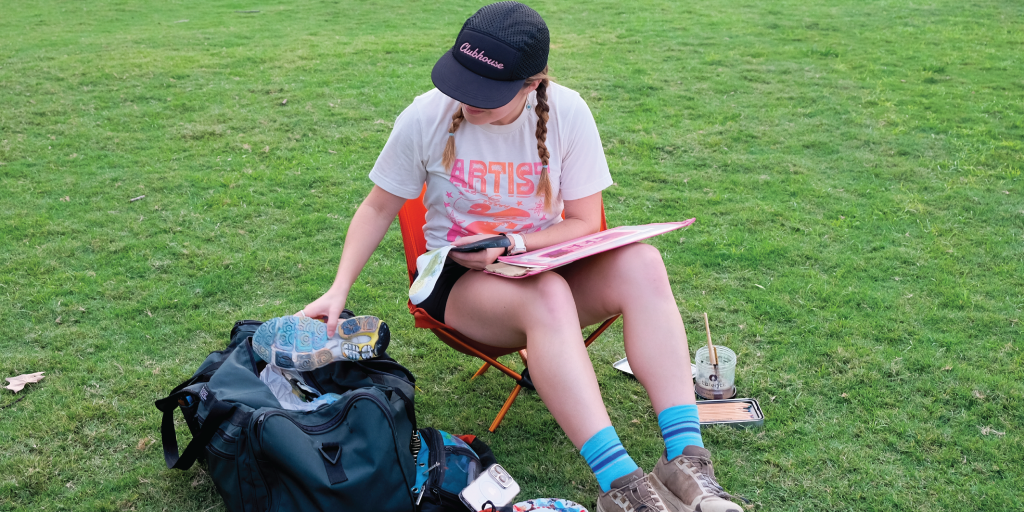
Thira with her art supplies at Zilker Park.
What inspired you to take action?
For most of my life, art, running, and sustainability have been core parts of my identity. It wasn’t until after I realized how much my gear impacted the environment that I had the idea to combine all three of my passions into one core practice.
It all began when I transferred from the School of the Art Institute of Chicago to Southwestern University in Georgetown, Texas, following the COVID-19 pandemic. As I was working toward my Bachelor of Fine Arts and Environmental Studies minor, three students and I were selected to attend the prestigious Tamarind Institute in Albuquerque, New Mexico, to learn the art of stone lithography from master printers in training. With only a week to come up with an idea and put it on paper, I was scanning aimlessly for items with interesting textures to print with that had a story to tell. I thought I was out of luck until I looked at the intricate patterns on the bottom of my running shoes.
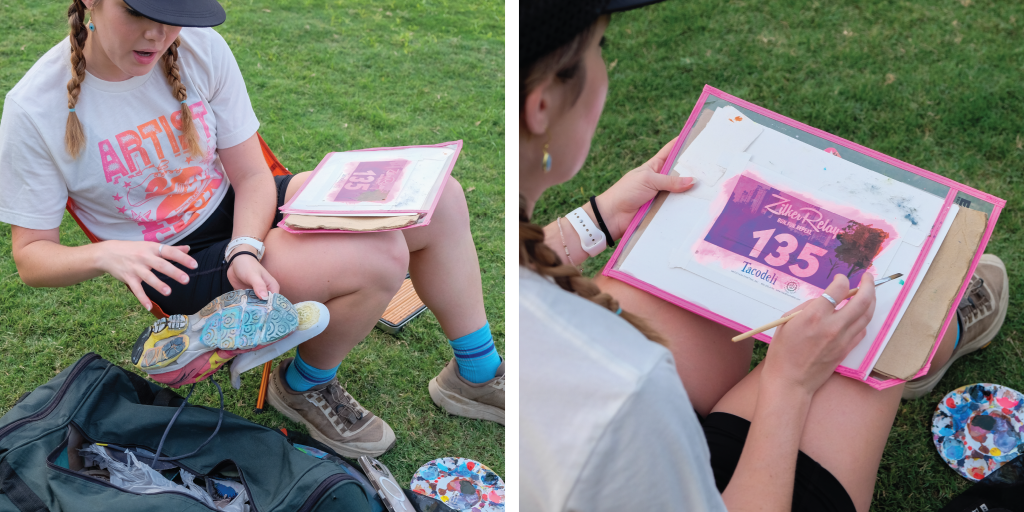
Left to Right: Thira shows some of the shoes she uses to make her prints; Thira paints on her race-day bib.
How did you do it?
Before arriving at the Tamarind Institute, I had just finished reading We Can’t Run Away From This, a book by ultrarunner and environmental activist Damian Hall about the impact runners have on the environment. Running shoes are made from a variety of plastics and fibers, which means they take years to break down. With that in mind, I got a pair of shears and cut my worn shoes until I was left with the bare bones and dissected pieces of fiber and plastic soles displayed across the table. I would eventually use these objects as printing tools to create texture in landscapes, making my first shoe-scape, titled “Tread Lightly.”
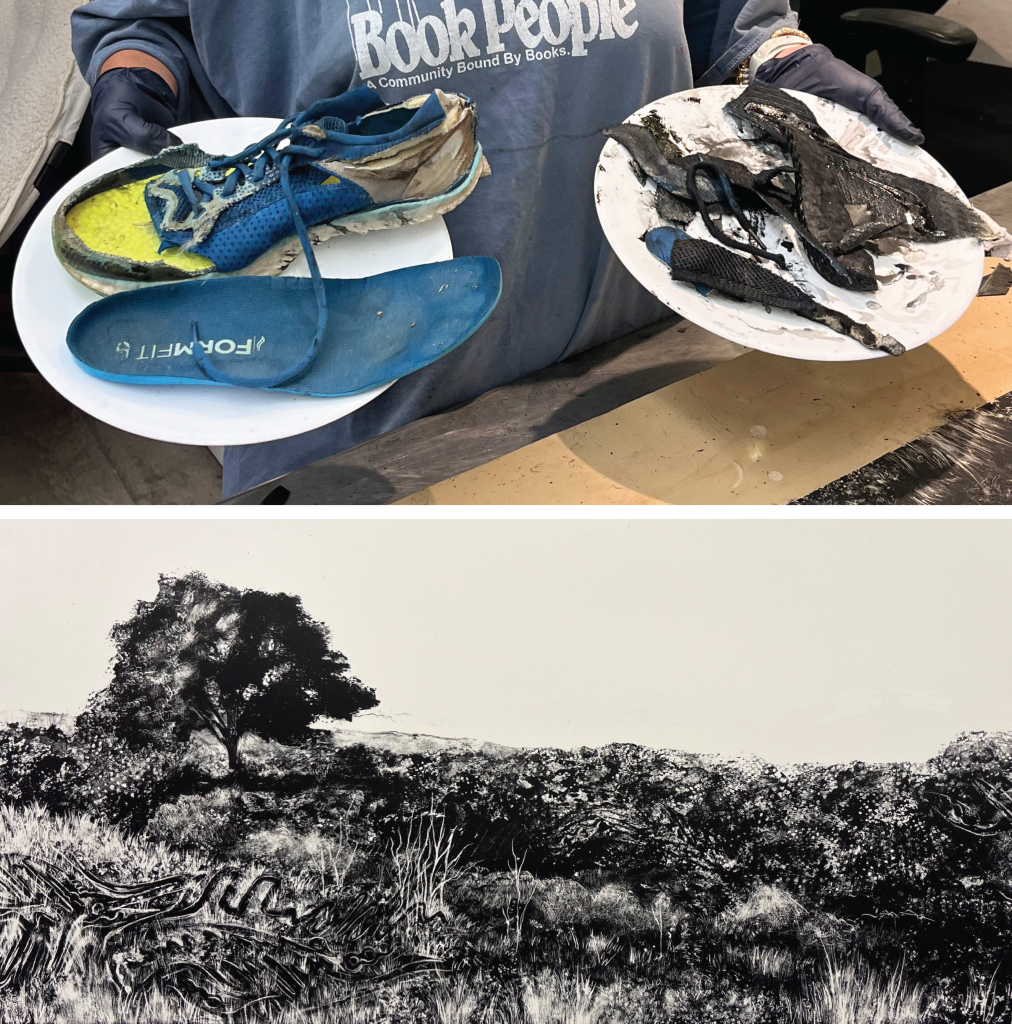
Top to Bottom: Repurposed shoe materials used to make the shoe-scape art; Thira’s first piece, “Tread Lightly.”
These shoe prints would eventually find themselves painted in the texture of rocks, trees, and skies of colorful landscapes I’ve run through, illustrating the effects humans and our used gear have on the environment we traverse. As I continued working with running shoes as a medium, I began to think about other items runners often throw away — one of those being race bibs.
Race bibs, secured by a few safety pins on shorts or a T-shirt to track someone during a race, are made from Tyvek paper. Due to its waterproof qualities for sweaty people like me, Tyvek is not recyclable and takes a long time to break down. This gave me the idea to use the Tyvek bib as a canvas to capture memories from my races. My most recent race, the Zilker Relays, was hosted at Zilker Park in downtown Austin. The glowing lights of the Austin skyline at twilight are what inspired my bib painting, “Twilight at Zilker Relays.”
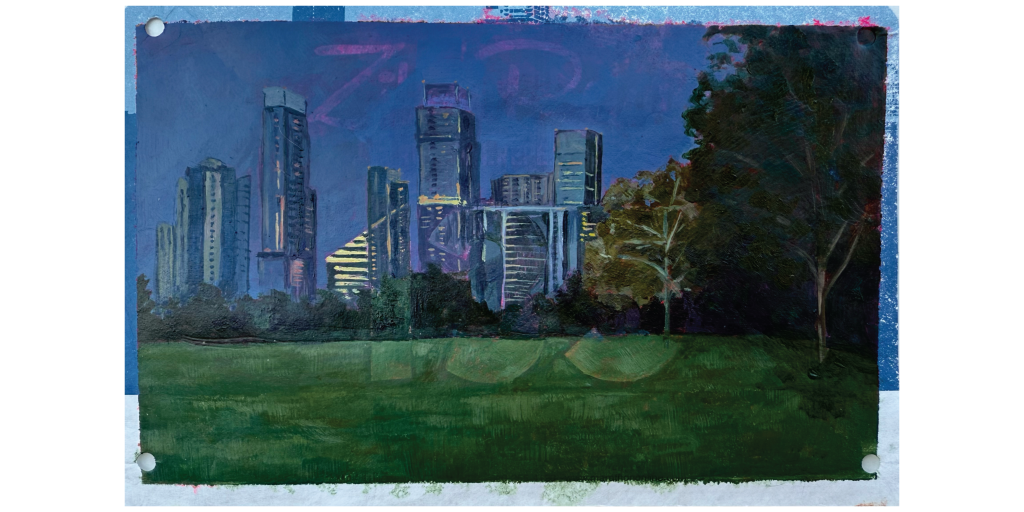
Bib painting, “Twilight at Zilker Relays”
What’s been most rewarding about getting involved in this way?
Finding creative ways to reuse worn running gear that I might have otherwise discarded has been a rewarding way to recycle. But my most meaningful experience by far was summiting Mount Kilimanjaro, the world’s largest free-standing mountain, in Tanzania. I was one of twelve Southwestern University students chosen for this trip of a lifetime. With my trail racing background and passion for plein air painting, I set out with a goal: to capture the landscape throughout the eight-day trek using a portable, lightweight easel and painting supplies. At the time, I had recently developed a technique of printing shoe pieces into my landscapes with my own worn-out shoes. What I didn’t expect was to discover a much deeper meaning in the discarded soles I found scattered along the trail.

Left to Right: Thira paints outdoors in Tanzania, Africa; Thira and her friend, Goodluck, hold the paintings they did of each other.
During our trip, we hired African porters to carry our gear, food, and other essential supplies. I befriended Goodluck, one of the porters, who was close to my age and an artist himself. We painted together the entire trip and had many deep conversations about our individual cultures. I asked Goodluck about the shoe pieces I kept finding along the trail, and he informed me that porters wear shoes donated to them by other hikers until they begin to fall apart and degrade into the trail. This opened my eyes to the privilege we encounter in America and the ability people have to discard their gear before it’s used to the fullest extent. I collected every shoe piece I found along the mountain and took them back home to make a series of pieces centered around my experience.
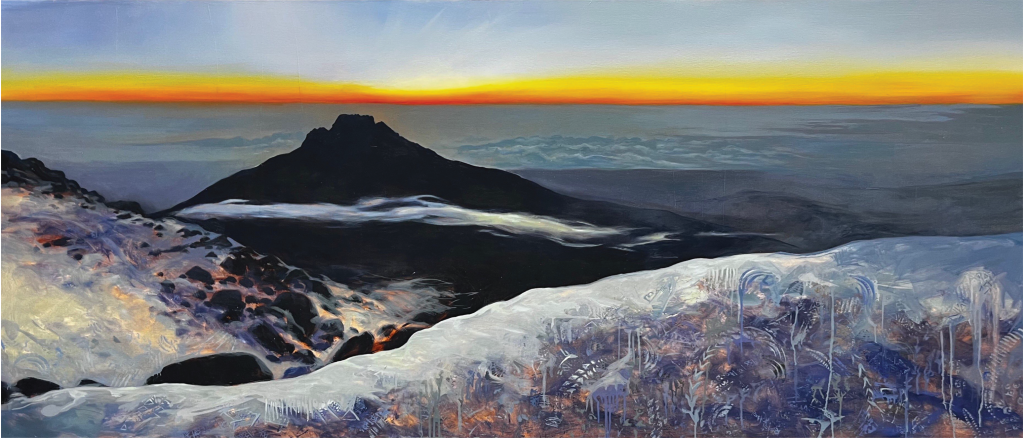
Thira’s piece, “What Lies Over the Horizon” using the shoe remnants on the hike to summit Mount Kilimanjaro.
What’s been the toughest part?
After the COVID-19 pandemic, running skyrocketed in popularity. Whether you run at a party-pace on the road or drink craft beers after a tough trail run, there’s a run club for whatever your niche might be. However, running companies have taken advantage of this growing trend by coming out with slightly new iterations of running shoes for every season, in every color you could imagine. More people travel across the globe for races just to earn a new shiny medal and snag another race shirt that will live in the depths of their closet. Running itself is a healthy hobby, but the unnecessary items that might come with it can harm the planet.
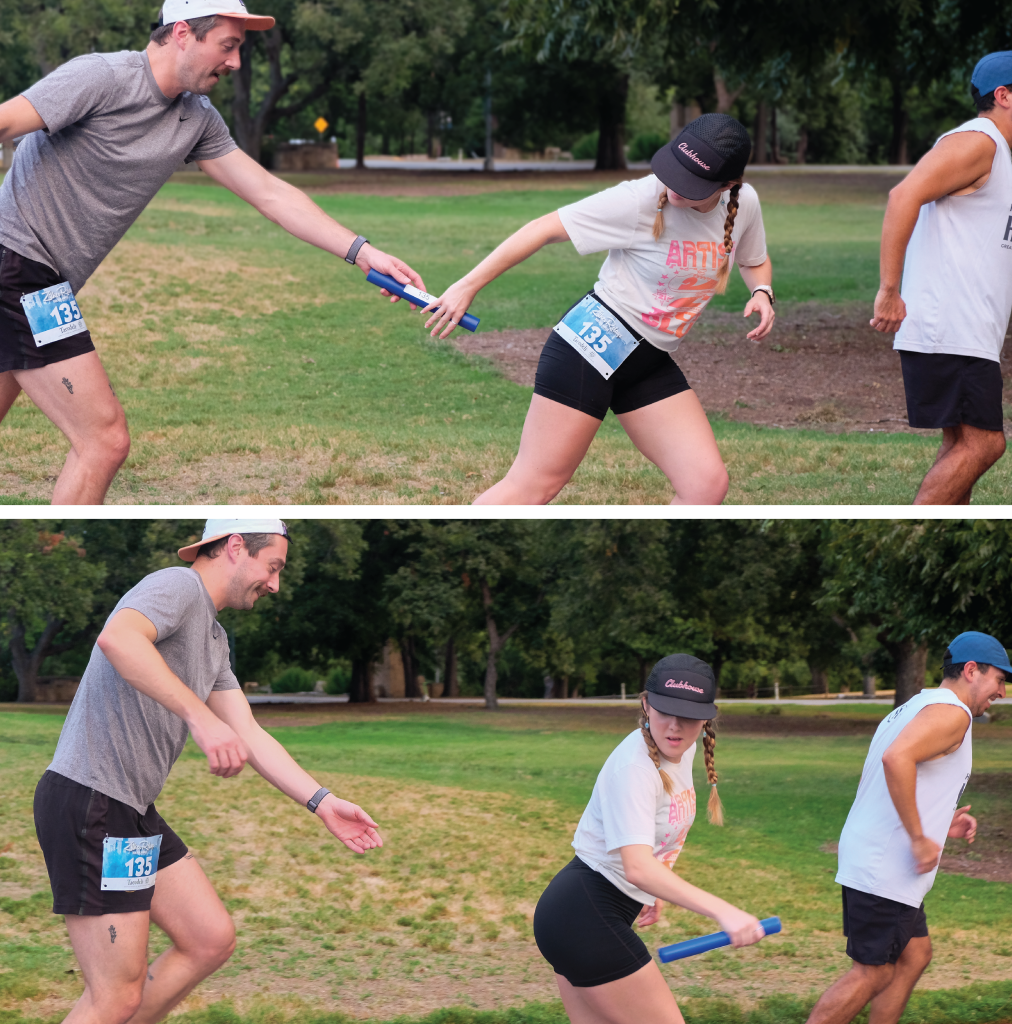
Top to Bottom: Thira’s running mate hands a baton off to Thira at Zilker Relays; Thira runs with the baton.
That’s where organizations like Racing for Sustainability give me hope for the future of running. Elite marathon runner and climate activist Tina Muir founded this nonprofit, aiming to help others make races more sustainable through environmentally-conscious race plans. These plans promote initiatives like cupless races and improved recycling station setups tailored to race size. I was fortunate to be accepted onto the Racing for Sustainability team for the Bank of America Chicago Marathon, where I will be fundraising to support the continuation of Racing for Sustainability. If you're interested in following my journey and helping me get to the start line for a good cause, find me on Instagram at @thirartist.
How has your art helped you spark conversations about climate and sustainability?
I’ve had the pleasure of showing my work in several galleries in and around Austin. These spaces provide me with an opportunity to share my work publicly with other runners, artists, and viewers who are curious about my work. I recently exhibited my work in the group show, Positioning Systems, at Northern-Southern gallery in downtown Austin. During a weekly Austin running group that I co-lead, “Artist Run Club,” I had the chance to speak about the meaning behind my work and why I feel it’s essential to preserve the gear that we own and make it outlast its capitalistic deadline.
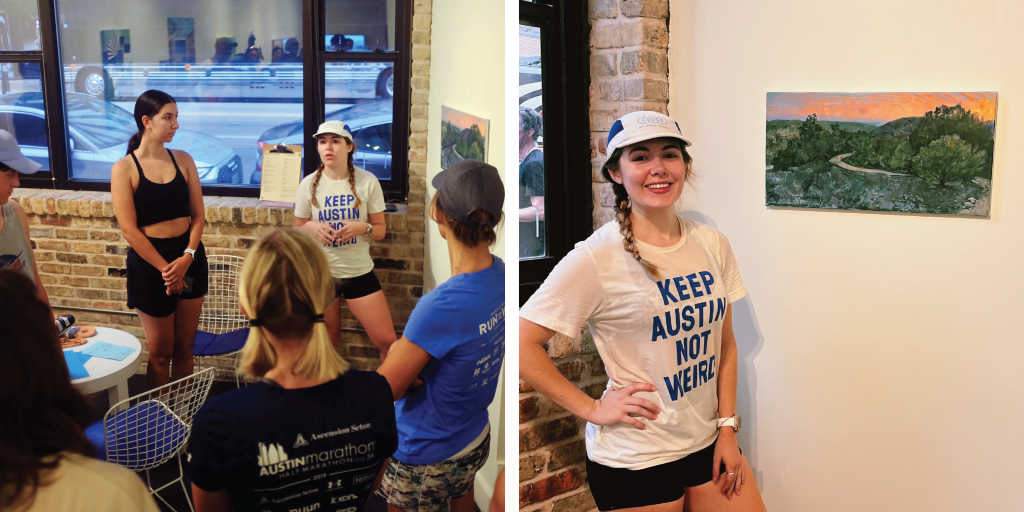
Left to Right: Thira presents her art at “Positioning Systems;” Thira poses with her shoe-scape artwork.
I believe art and running both have the power to unite us. Through experiences like attending races and groups, like “Artist Run Club,” I’ve come to feel that I’m on the right path to sharing complex issues we must face together through art and the love of running.
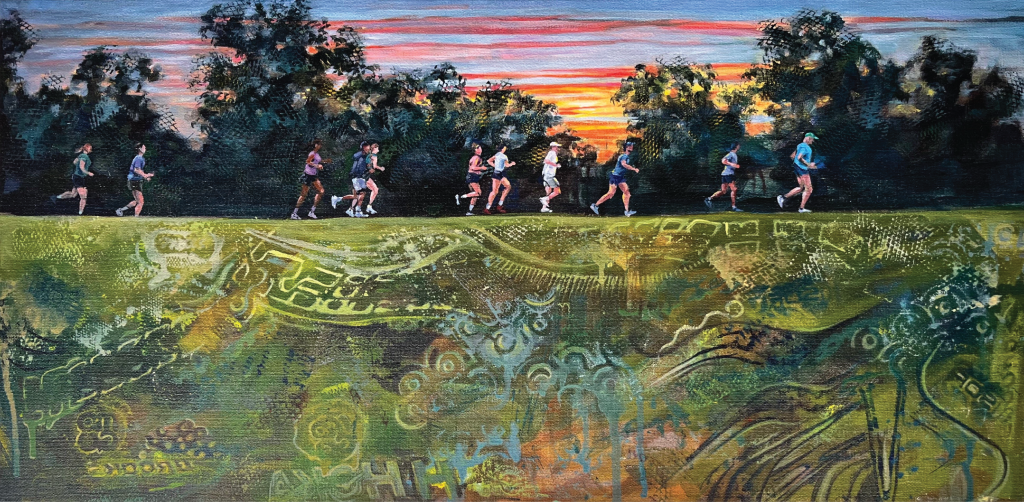
One of the pieces Thira presented at “Positioning Systems,” “Creative Soles”
What advice do you have for others?
While I choose to recycle my used gear through cutting it up, painting on it, and making it into art, that is certainly not the only solution. Next time you’re tempted to buy the newest pair of running shoes or gear up before trying to set a new personal record at your next race, ask yourself: Do I really need new shoes? Can I skip the race T-shirt? Where can I recycle my medal if I don’t want to keep it? How can I hydrate on race day without relying on plastic cups?
These are the kinds of thoughts and questions I want people to consider after viewing my work. If you’re part of a local running club, consider organizing a trail cleanup day or a “plogging” event (combining trash pickup with jogging). If you’re looking to run a local race, reach out to the race director to ask what kind of sustainable initiatives they have in place for race day. If your old shoes are no longer cutting it and you’re looking to upgrade for better physical health, do your research to find shoes that will outlast their desired mileage. In the rare times I do find myself buying new active wear, I thrift or buy local. Clubhouse Outfitters, a local athletic apparel store in Austin, aims to address the issue of mass production in active wear by prioritizing care and consideration in the items they produce and the fabrics they use.
The list goes on and on, but overall, be conscious of the gear you wear and the way you run as an individual and collectively.
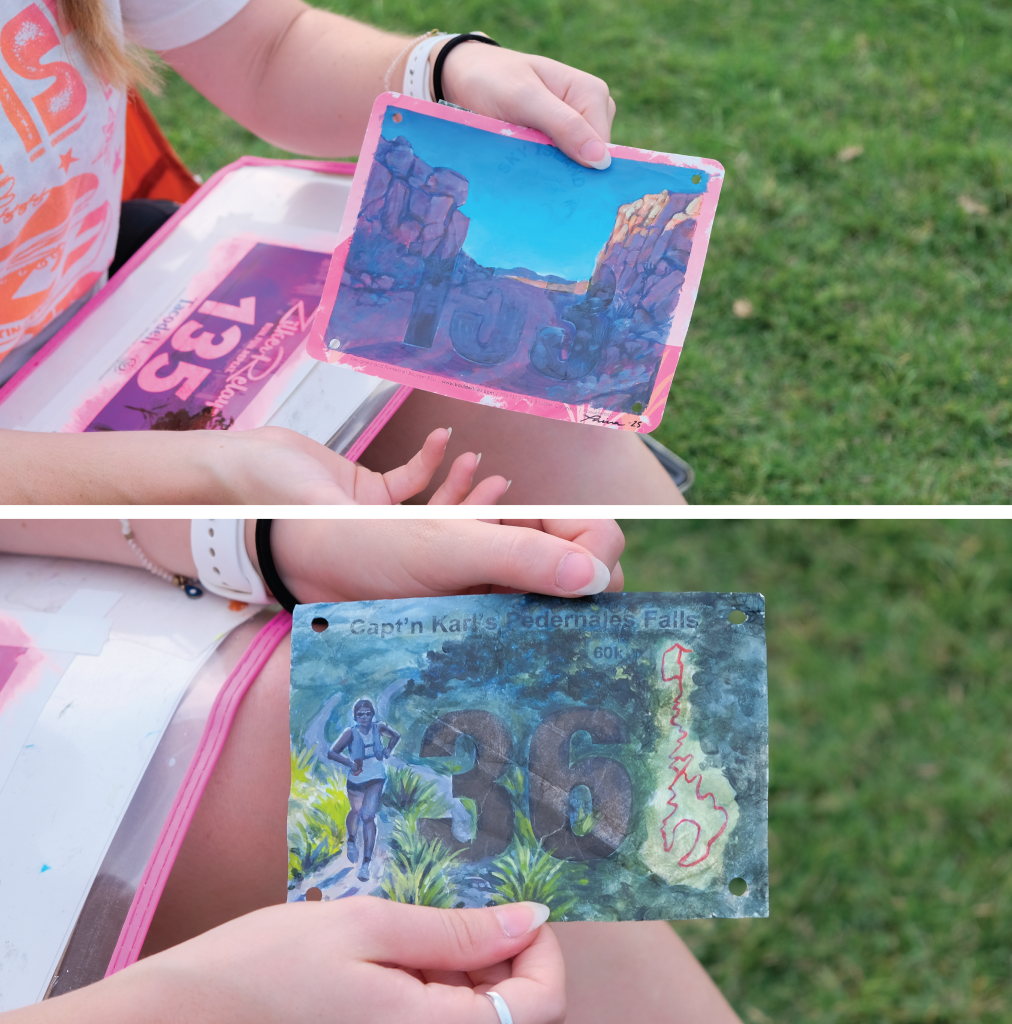
Thira shows a couple of her race bib paintings.
Is there a book, documentary, or other piece of media you would recommend for folks wanting to learn more about these topics?
I previously mentioned the book that initially got me thinking about the connection between running and sustainability, which was Damian Hall’s (@untra_damo), We Can’t Run Away From This. This book dives into the statistics, numbers, and in-depth research on why running can be so detrimental to the environment.
Building on those ideas, Becoming a Sustainable Runner, co-written by accomplished runners and environmental advocates Tina Muir (@tinamuir88) and Zoë Rom (@carrot_flowers_z), explores how to approach running sustainably through the lenses of mind, body, and planet. This book is also what led me to discover Muir’s nonprofit, Racing for Sustainability.
Lastly, Alaskan watercolor artist and storyteller, Max Romey (@trailboundsketches), is inspired by trash and other discarded materials to illustrate stories about how we must work to protect the planet from climate catastrophe. Romey even had an entire project dedicated to collecting discarded shoes on an island in Alaska and illustrating each of them to bring awareness to the effects microplastics have on the planet.
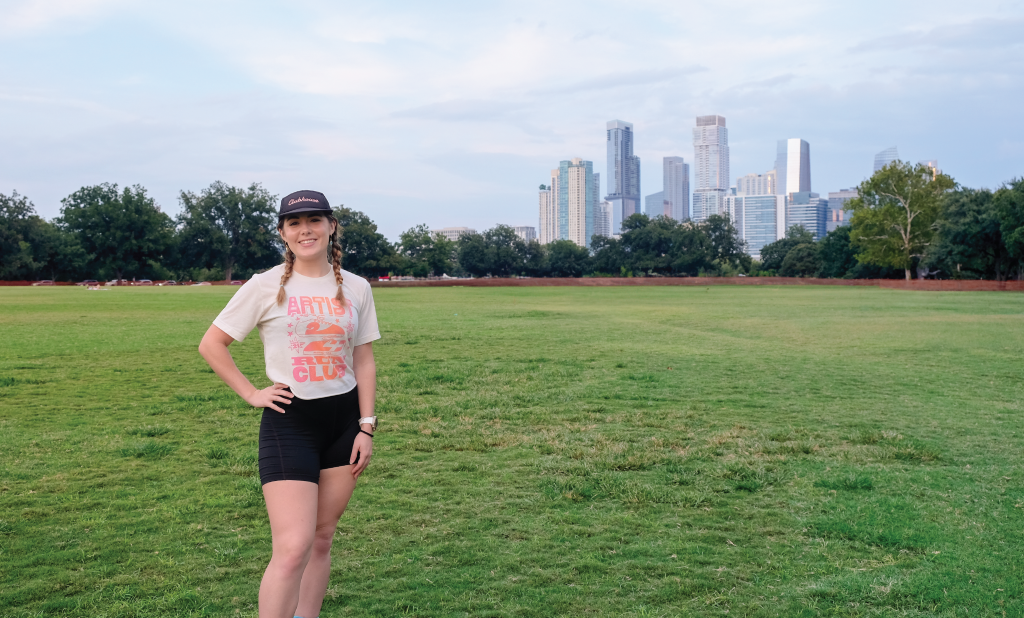
Thira poses at Zilker Park with Downtown Austin in the background.
Thira’s work reminds us that you don’t always have to go far to find sustainable ways to care for the planet — sometimes the greatest difference you can make starts with your everyday hobbies. Running has long been a favorite pastime in Austin, and Thira’s art highlights how even the gear we use for the activities we love carries an environmental footprint. She challenges us to rethink waste, find beauty in the overlooked, and make more intentional choices in our daily lives. To see more of her work and follow her journey, check out Thira on Instagram at @thirartist.
To learn more about Austin's net-zero goal and explore actions you can take to support a greener community, view the Austin Climate Equity Plan.
Share your Net-Zero contributions with us on X or Facebook, and use #NetZeroHero. If you know a Net-Zero Hero (or heroes!) who should be recognized for their efforts, send your nomination to climate@austintexas.gov.

